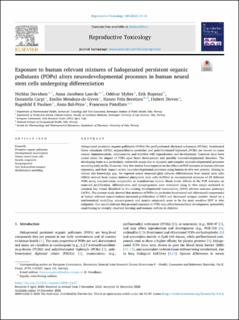| dc.contributor.author | Davidsen, Nichlas | |
| dc.contributor.author | Lauvås, Anna Jacobsen | |
| dc.contributor.author | Myhre, Oddvar | |
| dc.contributor.author | Ropstad, Erik | |
| dc.contributor.author | Carpi, Donatella | |
| dc.contributor.author | Mendoza-de Gyves, Emilio | |
| dc.contributor.author | Berntsen, Hanne Friis | |
| dc.contributor.author | Dirven, Hubert | |
| dc.contributor.author | Paulsen, Ragnhild Elisabeth | |
| dc.contributor.author | Bal-Price, Anna | |
| dc.contributor.author | Pistollato, Francesca | |
| dc.date.accessioned | 2021-11-23T14:31:37Z | |
| dc.date.available | 2021-11-23T14:31:37Z | |
| dc.date.created | 2021-01-05T13:13:57Z | |
| dc.date.issued | 2021 | |
| dc.identifier.citation | Reproductive Toxicology. 2021, 100 17-34. | |
| dc.identifier.issn | 0890-6238 | |
| dc.identifier.uri | https://hdl.handle.net/11250/2831066 | |
| dc.description.abstract | Halogenated persistent organic pollutants (POPs) like perfluorinated alkylated substances (PFASs), brominated flame retardants (BFRs), organochlorine pesticides and polychlorinated biphenyls (PCBs) are known to cause cancer, immunotoxicity, neurotoxicity and interfere with reproduction and development. Concerns have been raised about the impact of POPs upon brain development and possibly neurodevelopmental disorders. The developing brain is a particularly vulnerable organ due to dynamic and complex neurodevelopmental processes occurring early in life. However, very few studies have reported on the effects of POP mixtures at human relevant exposures, and their impact on key neurodevelopmental processes using human in vitro test systems. Aiming to reduce this knowledge gap, we exposed mixed neuronal/glial cultures differentiated from neural stem cells (NSCs) derived from human induced pluripotent stem cells (hiPSCs) to reconstructed mixtures of 29 different POPs using concentrations comparable to Scandinavian human blood levels. Effects of the POP mixtures on neuronal proliferation, differentiation and synaptogenesis were evaluated using in vitro assays anchored to common key events identified in the existing developmental neurotoxicity (DNT) adverse outcome pathways (AOPs). The present study showed that mixtures of POPs (in particular brominated and chlorinated compounds) at human relevant concentrations increased proliferation of NSCs and decreased synapse number. Based on a mathematical modelling, synaptogenesis and neurite outgrowth seem to be the most sensitive DNT in vitro endpoints. Our results indicate that prenatal exposure to POPs may affect human brain development, potentially contributing to recently observed learning and memory deficits in children. | |
| dc.language.iso | eng | |
| dc.title | Exposure to human relevant mixtures of halogenated persistent organic pollutants (POPs) alters neurodevelopmental processes in human neural stem cells undergoing differentiation | |
| dc.type | Peer reviewed | |
| dc.type | Journal article | |
| dc.description.version | publishedVersion | |
| dc.source.pagenumber | 17-34 | |
| dc.source.volume | 100 | |
| dc.source.journal | Reproductive Toxicology | |
| dc.identifier.doi | 10.1016/j.reprotox.2020.12.013 | |
| dc.identifier.cristin | 1865565 | |
| dc.relation.project | Norges forskningsråd: 204361 | |
| dc.relation.project | Norges forskningsråd: 213076 | |
| cristin.ispublished | true | |
| cristin.fulltext | original | |
| cristin.qualitycode | 1 | |
